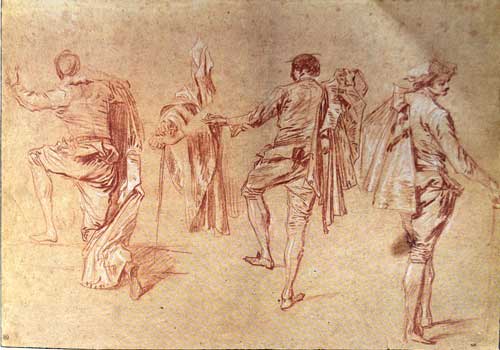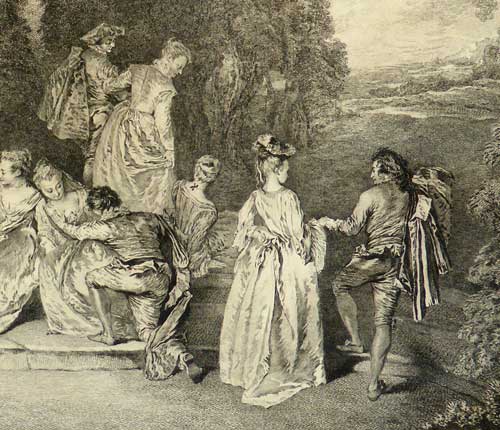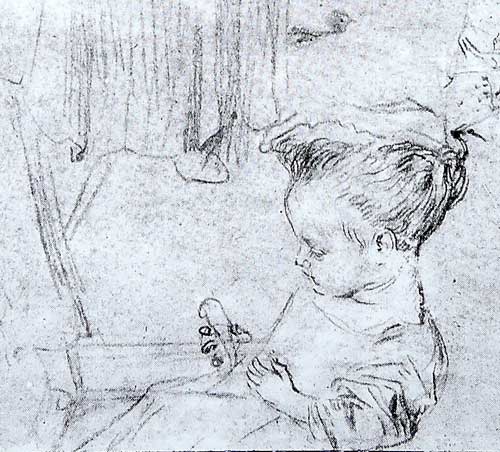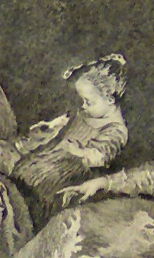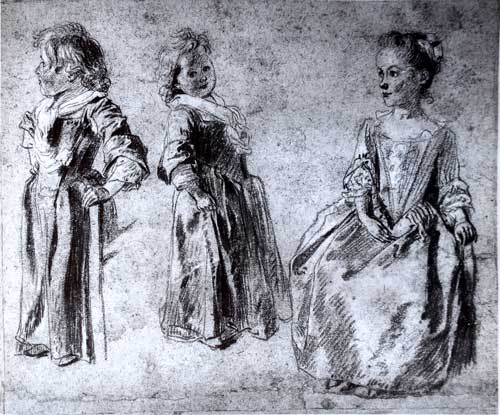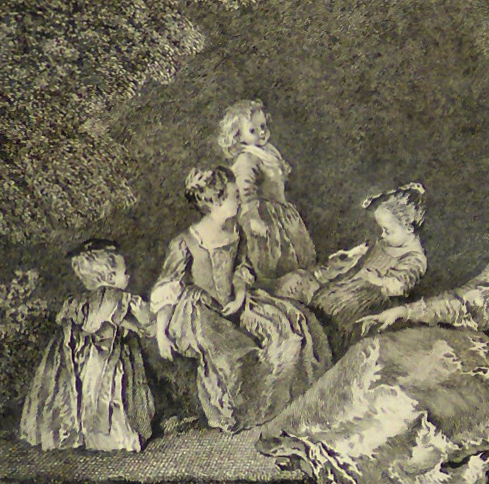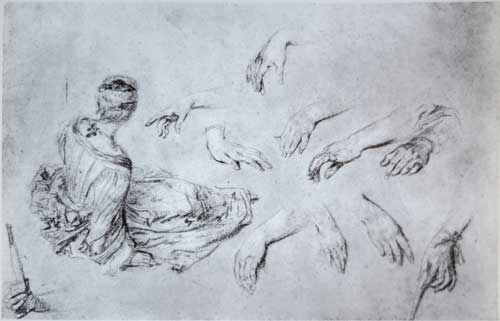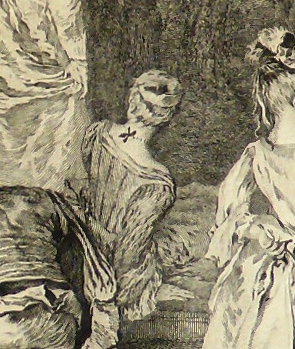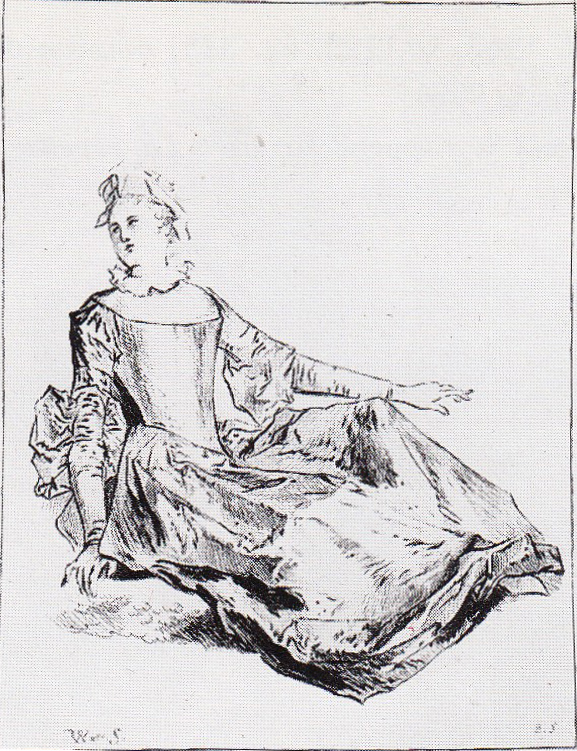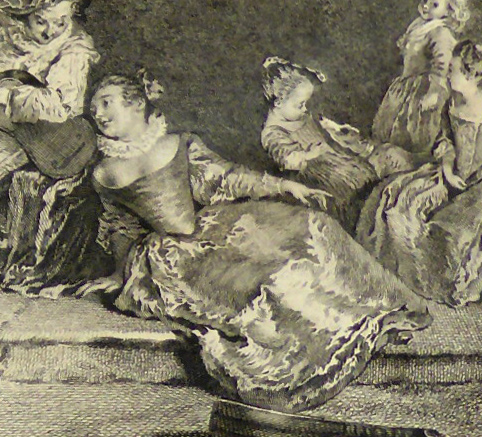
- Home Page
- Accepted
Paintings & Copies - Doubtful
Attributions - Doubtful Textual References
- Alternative
Titles - Collectors &
Museums - Bibliography
- Search Abecedario
- Watteau &
His Circle
L'Assemblée galante
Entered August 2015; revised September 2016

Presumed lost
Materials unknown
Approximately 37.1 x 51.6 cm
RELATED PRINTS
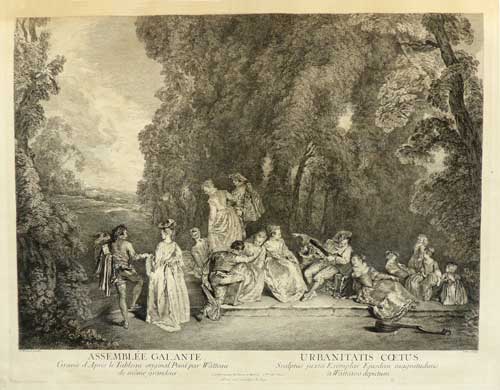
The painting was engraved in reverse by Jacques Philippe Le Bas in 1731 and was announced for sale in the November 1731 issue of the Mercure de France (p. 2623). The engraved caption states that the print was the same size (“de même grandeur”) as the Watteau painting.
PROVENANCE
Paris, collection of Jeanne Baptiste d'Albert de Luynes, comtesse de Verrue (1670-1736). Her ownership was declared on Le Bas’ engraving: “Ce tableau est dans le Cabinet de Made la Ctesse de Verrüe.” Her sale, Paris, March 27ff, 1737. Because of the vagueness of the descriptions of the Watteau paintings in the Verrue sale, it is not possible to identify L’Assemblée galante with any specific lot.
SELECT BIBLIOGRAPHY
Hédouin, “Watteau” (1845), cat. 83.
Hédouin, Mosaïque (1856), cat. 84.
Goncourt, “Oeuvre gravé de Watteau” (1859), 57.
Goncourt, Catalogue raisonné (1875), cat. 108.
Dacier, Vuaflart, and Hérold, Jean de Jullienne et les graveurs (1921-29), cat. 139.
Réau, “Watteau” (1928), cat. 142.
Adhémar, Watteau (1950), cat. 187.
Waterhouse, Waddesdon Manor (1967), under cat. 138.
Macchia and Montagni, Watteau (1968), cat. 171.Posner, Watteau (1984), 123, 197, 223,
Roland Michel, Watteau (1984), 97, 229, 271.
RELATED DRAWINGS
The relation of this composition to Watteau’s drawings is complicated by the picture’s close connection to another of his paintings, La Récréation galante in Berlin. Scholars are divided about the chronological sequence of the two versions and about Watteau’s dependance on his drawings and his method of replicating his compositions.
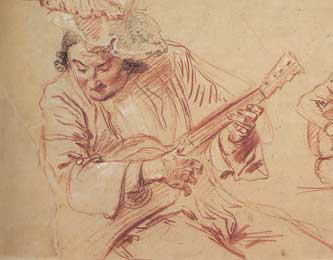
Watteau, Two Studies of a Guitarist and an Outstretched Arm (detail), red, black, and white chalk. London, British Museum.
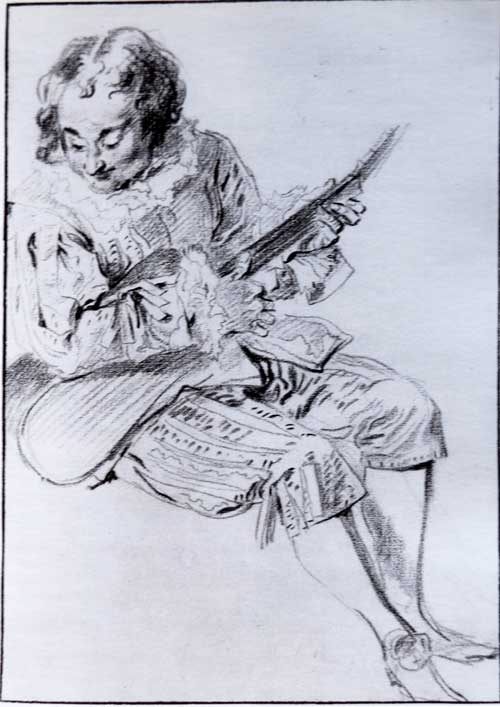
Watteau, Study of a Guitarist, red and black chalk, 26.9 x 18.9 cm. Rouen, Musée des beaux-arts.
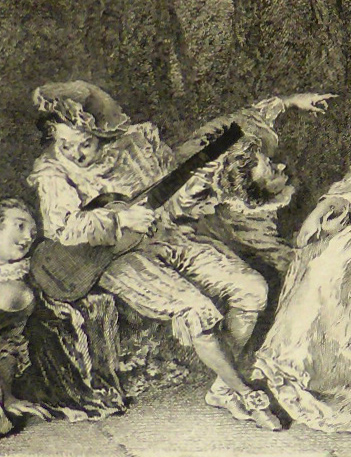
Jacques Philippe Le Bas after Watteau, L’Assemblée galante (detail), here reversed to the original direction of the painting.
As in Recréation galante, the guitarist at the near center of L'Assemblée galante is derived from two related drawings. The major aspects of his face, hands, and beret were taken from a sheet in the British Museum (Rosenberg and Prat 479), but details of his costume come from a separate study at Rouen (Rosenberg and Prat 591). The question that then arises is whether there was yet a third drawing from the model that combined these elements or whether, after establishing the combination in one version, Watteau then copied it in the second painting. Adding to the conundrum, the same guitarist with the same combination of features appears in Watteau’s La Gamme d’amour, now in the London National Gallery.
Also as in Récréation galante, a major source of inspiration for Watteau’s L’Assemblée galante was a sheet now in the Louvre with four studies of a man with a cape (Rosenberg and Prat 504). The study at the left of the sheet, showing a man kneeling, was used for the man to the right of center in the painting. Whereas his extended arm in the drawing made little sense, in the painting he is believably reaching out to his companion in a passionate way. The man toward the center of the drawing whose left leg is extended forward was placed at the far right of the painting where his extended arm and hand now brace the hand of his female companion, who is also mounting a step. Lastly, the man at the far right of the drawing has been moved slightly back in the painting and, together with his female companion, seems to be walking away from the terrace. Here is yet another example of Watteau's economy—taking several random figure studies from a single sheet and turning them into a meaningful ensemble. All these same figures appear in the Berlin Récréation galante.
The little girl playing with a dog in L’Assemblée galante was taken from a sheet in the Louvre (Rosenberg and Prat 229), where, however, the dog is absent and the child is preoccupied with something else. Although the child does not appear in Récréation galante, she is seen in other Watteau fêtes galantes, including La Déclaration, Le Prélude à un concert, Les Charmes de la vie, and Le Passe-temps. In all these other paintings a dog is present, but only in La Déclaration is it the same long-nosed breed shown here.
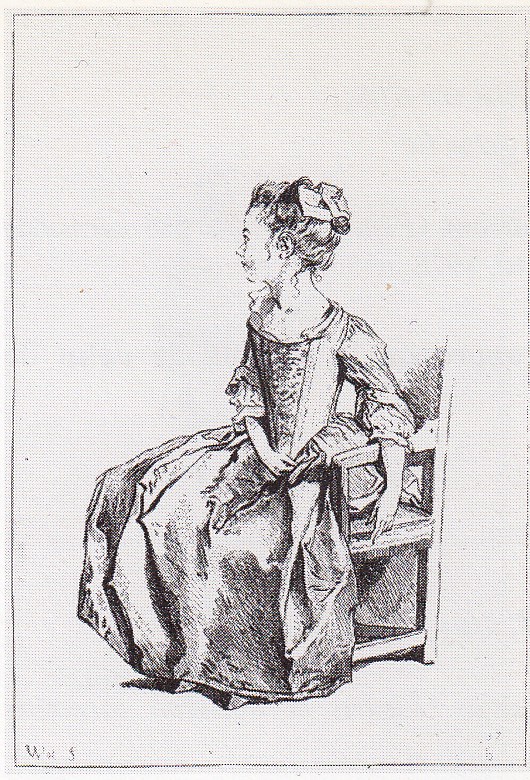
François Boucher after Watteau, Study of a Young Girl Seated in a Chair, engraving, Figures de différents caractères, plate 37.
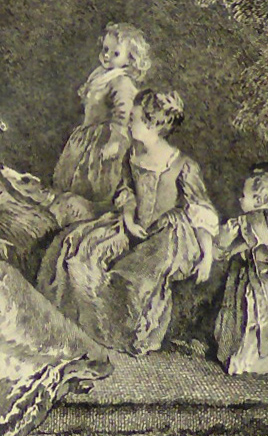
Jacques Philippe Le Bas after Watteau, L’Assemblée galante (detail).
The girl seated on a hillock at what would have been the right side of the painting was based on a drawing showing the young model seated in a chair. The drawing has not survived, but it is recorded in the Figures de différents caractères.
Another of the girls in L’Assemblée galante, the one standing erect and looking over her shoulder, was taken directly from a sheet of studies in Philadelphia (Rosenberg and Prat 508). The seated girl at the right side of the drawing seems to be the same model that is recorded on plate 37 of the Figures de différents caractères and, as just discussed, Watteau relied on for L’Assemblée galante. Most probably that lost drawing and the one in Philadelphia were near each other, if not in consecutive order, and as we see on countless occasions, Watteau tended to exploit clusters of nearby studies from his albums.
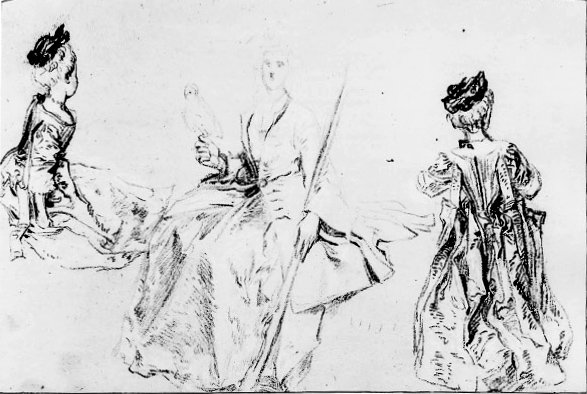
Watteau, Studies of a Huntress and Two Children, red, black, and white chalk, 25.2 x 39.2 cm. Berlin, Staatliche Museen zu Berlin, Kupferstichkabinett, Sammlungen der Zeichnungen und Druckgraphik.
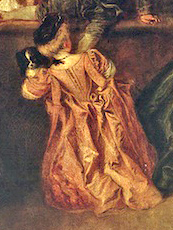
Watteau, Récréation galante (detail).
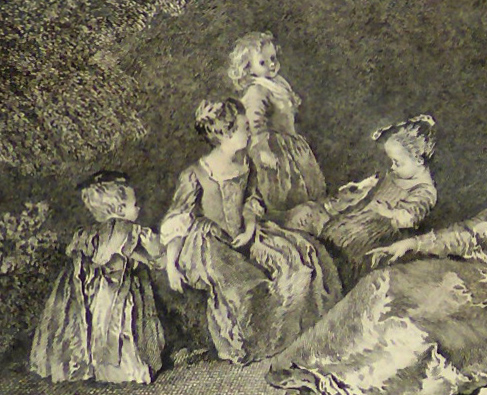
Jacques Philippe Le Bas after Watteau, L’Assemblée galante (detail), here reversed to the original direction of the painting.
The girl standing with her back to us at the side in L’Assemblée galante has generally been traced to a drawing in the Staatliche Museen zu Berlin (Rosenberg and Prat 182). On the same page are a seated huntress and a second study of the girl. In 1984 Rosenberg accepted the Berlin sheet in its entirety, but in 1996 he and Prat claimed that the two girls were spurious additions, copied from the engravings after them in the Figures de différents caractères. These scholars’ suspicion seems unnecessary, especially since the spirited draftsmanship exceeds what one could expect from a copyist. The rendering of the skirt of the seated child, for example, is fussy in the Figures de différents caractères, but in the Berlin drawing it is strong and decisive. Had these two girls been copied from the Figures de différents caractères they would be in the opposite direction like the engravings. Also the mise-en-page of this sheet is perfectly in accord with Watteau’s sensibility.
More troubling, however, are certain differences between the girl in the drawing and the one in the painting. Although they are unquestionably closely related, the shoulders of the one in the painting are not posed at such a steep angle and her skirt does not have the same pattern of deep, angular folds. One might dismiss these differences as minor, but they appear in some of the other paintings with this girl—Le Prélude au concert and Les Charmes de la vie. Moreover, in the latter two paintings and L’Assemblée galante the girl does not carry a pet on her shoulder, but she does in both Récréation galante and L’Occupation selon l’age. The complex relationships between Watteau’s original studies from the model and their employment in his paintings often raise more issues than can be answered.
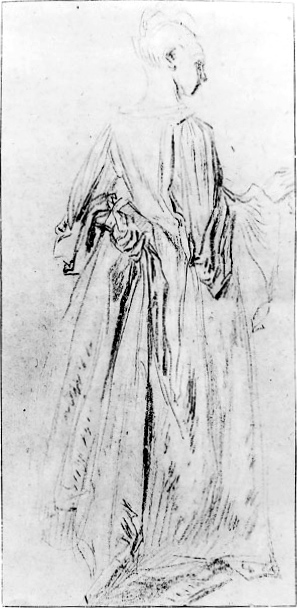
Watteau, Study of a Standing Woman, red and white chalk, 26 x 12.7 cm. Copenhagen, Statens Museum for Kunst, Den Kongelige Kobberstiksammling.
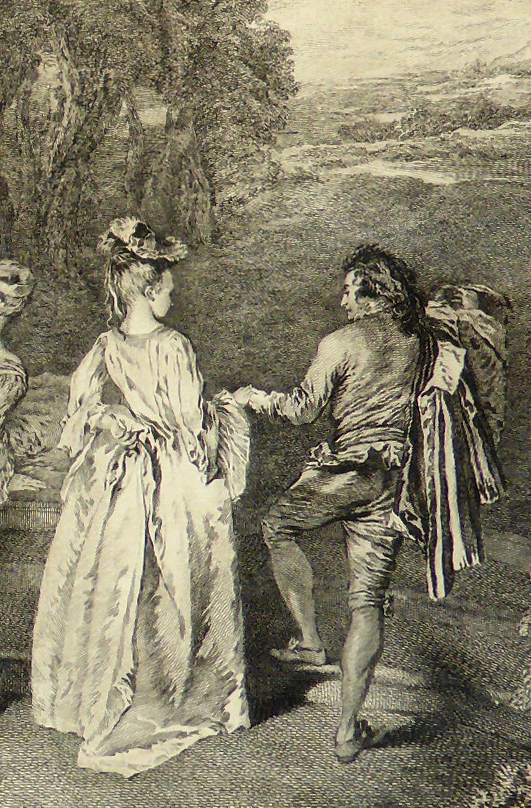
Jacques Philippe Le Bas after Watteau, L’Assemblé galante (detail), here reversed to the original direction of the painting.
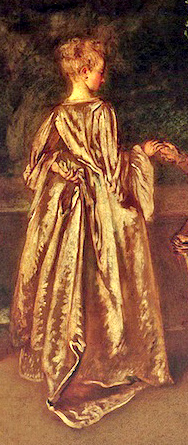
Watteau, Récréation galante (detail).
The woman at the right of L’Assemblé galante who, helped by her gallant companion, steps up onto the terrace and gently turns to the side—a motif that Watteau used to great effect in many fêtes galantes—was based upon a relatively slight figure study now in Copenhagen (Rosenberg and Prat 383). This skimpy study is concerned with her drapery more than her whole figure. While executing the painting, Watteau decided to embellish the woman’s costume, adding a hat set at a distinctive angle. This small detail, not present in either his drawing or in Récréation galante, proves, if nothing else, that Récréation galante was not based on L’Assemblée galante. The addition of this hat apparently occurred early on, when he was just laying in the figures without color; that state was recorded in a counterproof that he pulled from the canvas, and although the counterproof has not survived, it is recorded in plate 118 of the Figures de différents caractères—as discussed below.
The young woman farthest back in the painting, lying on the grass with her back turned to us, is based on a drawing in a private collection (Rosenberg and Prat 526).
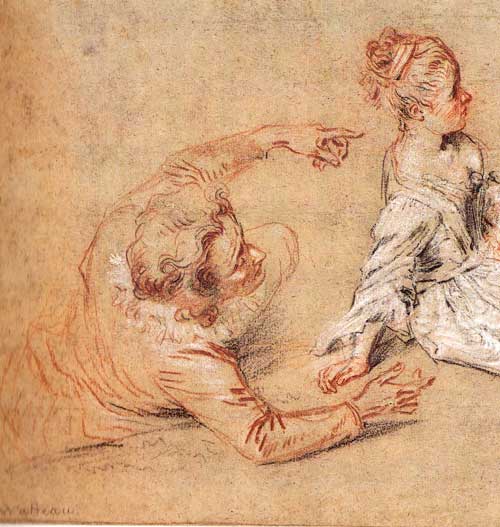
Watteau, Studies of a Man and Woman, red, black, and white chalk, 24.1 x 34.9 cm. Washington, National Gallery of Art.
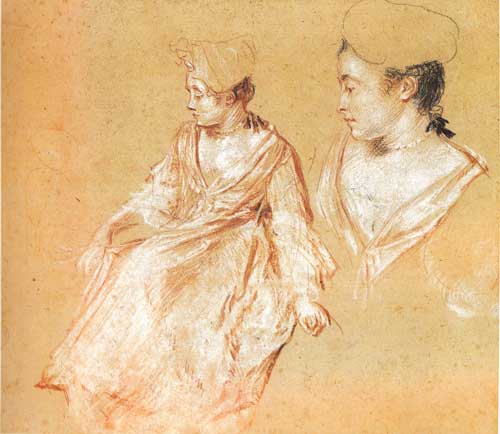
Watteau, Two Studies of a Seated Woman, red, black, and white chalk, 23.1 x 26.4 cm. Amsterdam, Rijksmuseum, Rijksprentenkabinet.
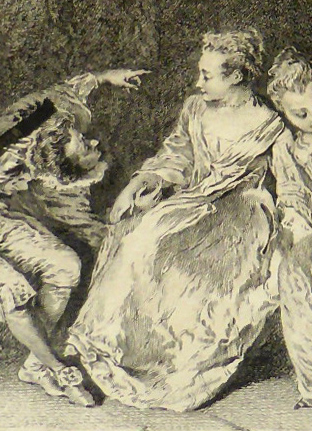
Jacques Philippe Le Bas after Watteau, L’Assemblée galante (detail), here reversed to the original direction of the painting.
The young man on the ground, largely hidden by the guitarist, was taken from a drawing now in the National Gallery of Art, Washington (Rosenberg and Prat 475). The woman to whom he gesticulates comes from a drawing in the Rijksmuseum (Rosenberg and Prat 476). This couple also appears in Watteau’s La Famille, and thus raises again the issue of how he worked. He may have used the same drawings for both paintings and, more important the same pairing of figures. In what sequence were the two compositions painted, or were they done at approximately the same time?
The girl whom the guitarist is serenading is thought to have been based on a now-lost drawing recorded on plate 229 of the Figures de différents caractères. In the painting, however, her body is much more steeply inclined, the folds of her skirt and sleeve differ, the ruff around her neck is richer, and her beret has been replaced by a flower in her hair. The lost drawing was a study from the early part of Watteau's career—as revealed by the exaggeratedly long, scrawny proportions of the woman’s body. In the painting her body is more ample and voluptuous in accord with his mature style. Did Watteau make these changes as he painted or did he rely on another, later drawing?
REMARKS
At least as far back as Edmond de Goncourt, the comtesse de Verrue’s Assemblé galante was associated with lot 70 in the 1737 sale of her collection: "deux petits tableaux peints par Gillot ou Watteau.” Yet L’Assemblée galante was not a small work and thus does not correspond to that particular entry. Nonetheless, de Goncourt’s idea was followed by Dacier, Vuaflart, and Hérold, who postulated that the other small painting in lot 70 was Heureux âge! Âge d’or. The association of the diminutive Heureux âge with one of the “deux petites tableaux” is reasonable but that picture, measuring 20.7 x 23.7 cm, is half the presumed size of L’Assemblée galante. Waterhouse has also reiterated the idea that L’Assemblée galante was one of Verrue’s “petits tableaux.”
The Verrue sale catalogue exists only in manuscript form, with differences between the several extant copies; the references here are to the copy in the Frick Art Reference Library. Within that sale were several other lots that might more appropriately describe L’Assemblée galante. Lot 71, “guillot ou vateau . . . Deux Tableaux,” brought the impressive price of 400 livres. Lot 143 was a group of paintings: “des Tableaux De Wouvermans, de Teniers et de Watteau en tout 12,” and these brought 450 livres (not as sizable a sum but one cannot gauge what constituted the rest of the lot). Lot 144 contained “plussieurs autres [Tableaux] de watteau,” which sold for 60 livres. Lot 145 (mistakenly written as 146) and described as “Vatteau . . . un autre Tableaux representan un bachanale” sold for 61 livres.
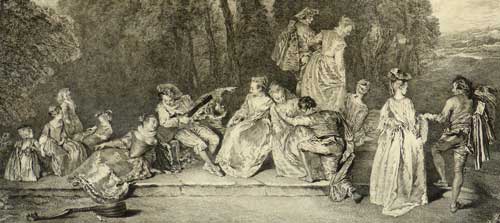
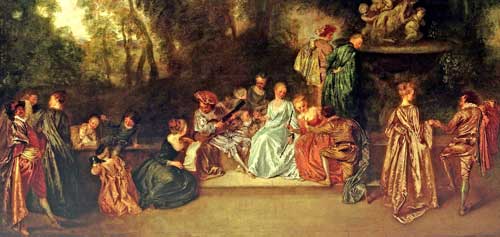
One of the most intriguing questions surrounding this painting is its relation to Watteau’s Récréation galante, now in Berlin. Since they share eight figures and their compositions are essentially comparable, the question arises as to which version was painted first. There are several other instances in Watteau’s oeuvre of his executing closely related compositions, one considerably smaller than the other. One such pair is the large-scale Divertissements champêtres and the much smaller Les Champs Elisés, both now in the Wallace Collection. Another pair is the Pelerinage à l’Ile de Cythère and the smaller Bon voyage. Apropos of the first example, Roland Michel and Vogtherr argue that the smaller version came first. In regard to the Pélerinage and Bon voyage, it seems probable that the smaller, reduced version was made later. In fact, one might well wonder if Watteau ever adopted a consistent work pattern. Apropos of L’Assemblée galante and Récréation galante, there is yet another alternative, namely that the two paintings were painted at approximately the same time. That is intimated in the relation of the drawings to the paintings. As has been shown, for both paintings Watteau seems to have reverted to his original drawings rather than copying whichever painting he executed first. But most telling of all, when he turned to the drawing of the woman seen from behind and reclining on the ground, he also used one of the studies of hands on this same sheet for Récreation galante. This may indicate (but certainly does not prove) that he had all these drawings out at the same time and worked on the two pictures simultaneously.
It is generally agreed that L’Assemblée galante is a mature painting. Posner, for example, calls it “late in his career” but is no more specific than that. Mathey suggested the date 1716 (which seems too early), while Adhémar more reasonably dated it to 1717-18. Macchia and Montagni assigned it to 1717. Rosenberg and Prat date many of the drawings related to this painting to c. 1716-17, but date the study of the guitarist in the British Museum to 1717-18, which would establish a terminus post quem comparable to Adhémar’s dating of the work.
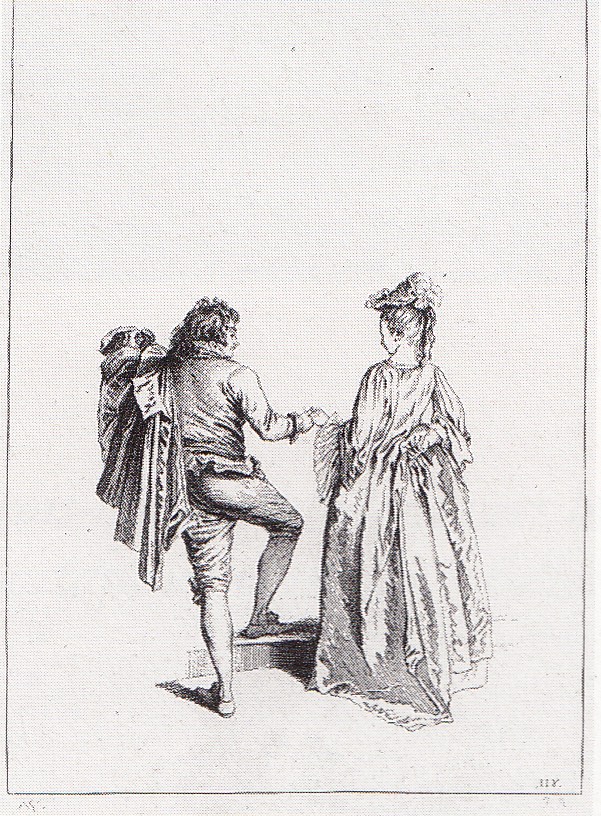
Jean Audran after Watteau, Study of a Couple Mounting a Step, engraving, Figures de différents caractères, plate 118.
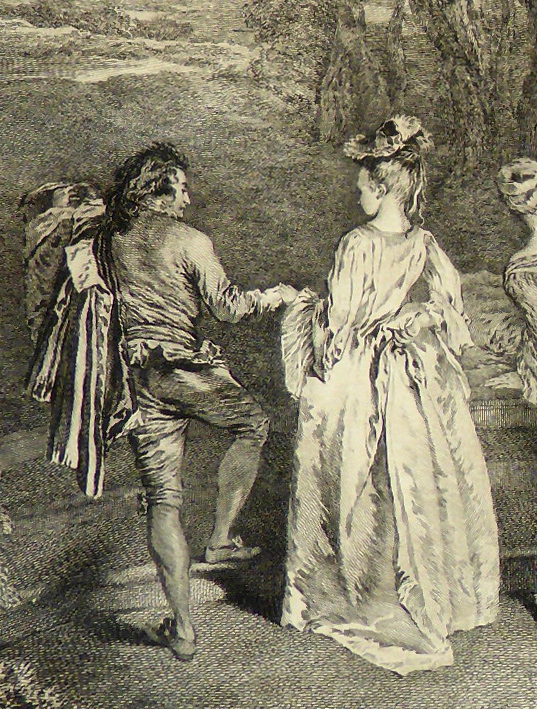
Jacques Philippe Le Bas after Watteau, L’Assemblée galante (detail).
While Watteau was laying out the design of L’Assemblée galante on the canvas, he pulled an oil counterproof of the couple at the extreme right side of the composition (thus at the left side of the engraving). This counterproof is no longer extant, but it is recorded in plate 118 of the Figures de différents caractères. Although the same couple appears in Récréation galante, there the woman is bareheaded, as she is in the original study from the model. However, when Watteau painted her in L’Assemblée galante, he gave her a hat cocked at an angle and that embellishment was present in the counterproof, as can be seen in Audran’s plate for the Figures de différents caractères.
For copies of L’Assemblée galante CLICK HERE
